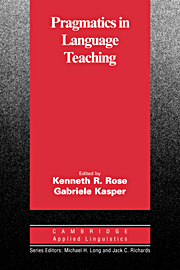Book contents
- Frontmatter
- Contents
- List of contributors
- Series editors' preface
- Preface
- Chapter 1 Pragmatics in language teaching
- I THEORETICAL AND EMPIRICAL BACKGROUND
- II ISSUES IN CLASSROOM-BASED LEARNING OF PRAGMATICS
- III THE EFFECTS OF INSTRUCTION IN PRAGMATICS
- Chapter 7 Acquiring French interactional norms through instruction
- Chapter 8 Inductive and deductive teaching of compliments and compliment responses
- Chapter 9 The role of input enhancement in developing pragmatic competence
- Chapter 10 Explicit and implicit teaching of pragmatic routines: Japanese sumimasen
- Chapter 11 Explicit instruction and JFL learner's use of interactional discourse markers
- IV THE ASSESSMENT OF PRAGMATIC ABILITY
- References
- Name index
- Subject index
Chapter 7 - Acquiring French interactional norms through instruction
Published online by Cambridge University Press: 05 October 2012
- Frontmatter
- Contents
- List of contributors
- Series editors' preface
- Preface
- Chapter 1 Pragmatics in language teaching
- I THEORETICAL AND EMPIRICAL BACKGROUND
- II ISSUES IN CLASSROOM-BASED LEARNING OF PRAGMATICS
- III THE EFFECTS OF INSTRUCTION IN PRAGMATICS
- Chapter 7 Acquiring French interactional norms through instruction
- Chapter 8 Inductive and deductive teaching of compliments and compliment responses
- Chapter 9 The role of input enhancement in developing pragmatic competence
- Chapter 10 Explicit and implicit teaching of pragmatic routines: Japanese sumimasen
- Chapter 11 Explicit instruction and JFL learner's use of interactional discourse markers
- IV THE ASSESSMENT OF PRAGMATIC ABILITY
- References
- Name index
- Subject index
Summary
Introduction
The emergence of intercultural competence in language teaching (Kramsch, 1993, 1995; Lustig & Koester, 1993; Byram & Zarate, 1994; Crozet, Liddicoat, & Lo Bianco, 1999) has led to a need to focus on a second language as a vehicle for communication in cultural contexts, and this in turn implies that an important goal for language learning is developing an understanding of appropriate communication in the target language (Zarate, 1986; Buttjes & Byram, 1990; Kramsch, 1995; Tickoo, 1995; Fantini, 1997; Liddicoat, 1997b). Consequently, language teaching now needs to be seen more in the context of intercultural communication, with the aim of preparing learners to communicate outside their own cultural boundaries (Bolten, 1993; Crozet, 1996; Liddicoat, 1997b; Liddicoat & Crozet, 1997; Liddicoat, Crozet, Jansen, & Schmidt, 1997; Crozet & Liddicoat, 1999; Crozet et al., 1999). In such a perspective, pragmatic and discoursal practices become an integral part of language learning from early on because they play a central role in intercultural communication, and mismatches between them have been identified as a key factor in communication breakdowns. Many studies have shown that culturally based differences about what is expected during communication can be a significant cause of crosscultural communication difficulties (Gumperz, Judd, & Roberts, 1979; Wierzbicka, 1985, 1991; Kotthoff & Auer, 1987; Gudykunst & Kim, 1992). These expectations may be linked to differences in the realization of particular speech acts, or they may be linked to broader, and often more diffuse, issues of discourse organization and conversational style.
- Type
- Chapter
- Information
- Pragmatics in Language Teaching , pp. 125 - 144Publisher: Cambridge University PressPrint publication year: 2001
- 28
- Cited by



